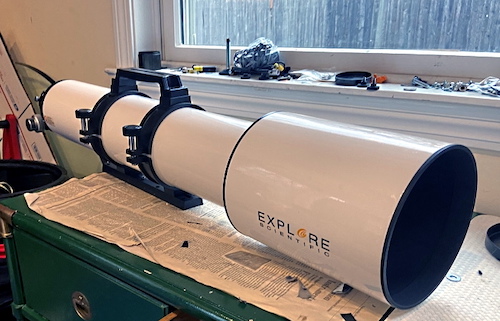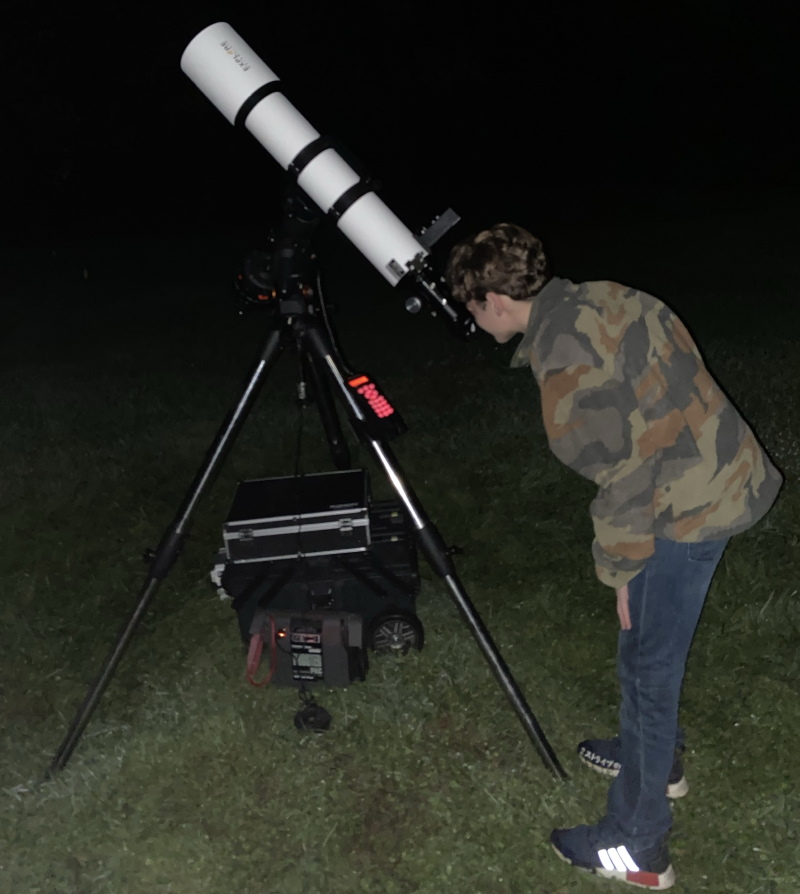Explore Scientific’s ED Essentials line promises true triplet apochromatic performance at a price almost as low as most other ED (extra-low dispersion glass) doublet refractors. We’ll be looking at the largest of the Essentials scopes, the 127ED.

The Essentials line sells for mostly visual users or those on a budget. If you’re interested in serious deep-sky astrophotography, and you’re willing to spend a few hundred extra dollars, the FCD100 upgrade offers (at least theoretically) slightly better color correction, hexagonal focusers which are more suitable for heavy cameras, and a larger non-vignetted image circle, in part due to said focuser.
When simply looking through the telescope the difference is basically unnoticeable, so most of my comments concerning the Essential 127ED can apply to the FCD100 version.
Both the Essentials and FCD100 127ED are available with carbon fiber tubes. These lighten the scopes by a few pounds and avoid the expansion and contraction problems that can sometimes occur when imaging with a metal tube.
With all that in mind, let’s get to the review.
Overview of Essentials 127ED
The Essentials 127ED uses Hoya FCD1 glass, which is basically the same as the Schott/Ohara’s FPL-51 glass. This is cheaper than the FPL-53 glass widely used in most doublet and triplet apochromatic refractors today, which is some of the most expensive optical glass that money can buy.
That being said, the glass for any scope is irrelevant if the optical design isn’t very good, and you should never buy a scope solely based on what glass it uses because that would be stupid.
There are a lot of bad FPL-53 doublets and triplets out there that perform worse at controlling chromatic aberration than the Essentials 127ED. The Essentials 127ED’s long focal ratio further helps keep chromatic and other aberrations at stay at bay. Compared to a regular achromatic or ED doublet, the 127ED has significantly less chromatic aberration and a flatter field for astrophotography.
Optically, the Essentials 127ED performs very well. The only false color you are ever going to see is a very slight purple fringe on bright stars like Vega, Sirius, and Arcturus, and you may even have to look for this said fringe.
Compared to a cheaper achromat or even a reflector, double stars require less magnification to split due to the higher contrast of the Essentials 127ED.
View-wise, the scope is comparable to an 8 inch reflector, as the EMD coatings, dielectric diagonal, and lack of a central obstruction give it higher contrast and light throughput.
The focuser on the Essentials 127ED is a fairly inexpensive but well-made dual-speed Crayford. If you aren’t happy with it, it’s not difficult to swap it out for a Moonlite, Feathertouch, or other aftermarket units, which, while expensive, all pale in comparison to the cost of the Essentials 127ED by the time it is mounted and accessorized.
The Essentials 127ED’s lens cell is collimatable, though collimating any refractor is an especially terrifying process and you will hopefully not have to do it.
The scope comes with Explore Scientific’s standard finder shoe, which locks onto your finderscope with two nylon thumbscrews. While it has a superior design compared to the standard Vixen/Synta shoes, it prevents you from using other brands of finders (besides Meade and Bresser).
This is without having an awkward-looking and tall adapter, or removing the shoe (which requires removing the focuser and being very careful not to drop any hardware on the objective lens).
Accessories
The diagonal supplied with all Explore Scientific apochromats is a 2-inch dielectric mirror unit with a carbon-fiber body. It is easily one of the best diagonals on the market today. The Essentials 127ED also comes with two extension tubes to reach focus with the diagonal, and an eyepiece.
Unlike many scopes, the 127ED has a handle attached to the tube rings, which is helpful, considering the scope’s 18 pounds (8.16 kilograms). The tube rings are attached to a standard Vixen-style dovetail.
The Essentials 127ED used to come supplied with a case, however, this is no longer true. There are cases for ED80 and ED102, however.
If you are considering this scope for visual use, and don’t already have a set of eyepieces, I would recommend at the minimum buying a 30-40 mm 2 inch wide-angle eyepiece, a ~24 mm wide-angle eyepiece, and a few others that are in the 6, 9, and 15 mm focal length range.
Explore Scientific is one of the best and most well-known eyepiece manufacturers out there, and they offer eyepieces at virtually every focal length, apparent field of view, and price.
Mounting

A heavy apochromatic triplet like the Essentials 127ED needs a good mount. Explore Scientific offers absolutely nothing in the way of mounting suggestions, so some users often buy rather lightweight mounts or even mounts that are plainly incapable of holding the scope.
For visual use, if you want something that’s plain, simple, fast to set up, and easy to use, you might want an all manual alt-azimuth mount. Explore Scientific’s own Twilight II will work well to hold the 127ED, and has two saddles so you can put another scope beside it, but the Twilight II has no slow-motion controls.
Vixen’s StarGuy could theoretically do the job (barely), but in practice, it’s probably undersized for the Essentials 127ED. Tele-Vue’s Gibraltar will work very well, but it is very expensive.
If you’re not interested in an alt-azimuth mount, an EQ-5 class German equatorial mount is enough to hold the scope for visual use. The Celestron Advanced VX, Orion Sirius, Meade LX85, Sky-Watcher HEQ5, iOptron CEM25p, Losmandy GM-8, and Explore Scientific’s own EXOS-2GT are all excellent choices for visual and limited astrophotography capability.
An EQ-5 class mount will, however, struggle with exposures longer than 40-60 seconds, even with autoguiding. So for deep sky astrophotography, you probably want to step it up to an EQ-6.
The Orion Atlas, Sky-Watcher EQ6R, and Losmandy G11 (the latter of which Explore Scientific offers with a wireless controlled deluxe GoTo system). Keep in mind that for any of these mounts, you will need to buy a Losmandy-style dovetail and bolt it to the tube rings, or buy a Losmandy-to-Vixen adapter for your mount.
Astrophotography
In addition to an EQ6 mount previously discussed, for serious deep-sky astrophotography you’ll need an autoguiding setup. Mounting a guide scope will require replacing the ES/Meade shoe for a Synta-style one, or removing the tube carry handle and putting a dovetail on top of it. A 30 or 50 mm guide scope will be more than adequate for guiding with a planetary/guide camera.
A field flattener is recommended for good astrophotos, ones that don’t look like you’re flying forwards the focused target at warp speed. Explore Scientific sells one that works great with DSLRs, although it requires adapters and tweaking the spacing to get a non-DSLR camera to work with it.
Conclusion
If you are a beginner in this hobby, the high price and the a-la-carte nature of the Essentials 127ED may scare you. Even the most inexpensive accouterments will probably result in you spending £1,600, or even £2,000 on the scope, and an imaging setup may be north of £2,800.
But the investment is worth it, whether for visual use or astrophotography. For visual, you’ll have pinpoint stars, near-perfect color control, excellent contrast, and jet black backgrounds that provide images comparable to an 8 inch Dob. For astrophotography, the Essentials 127ED provides tack sharp stars with a field flattener and a good all-around focal length.
